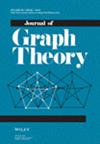求助PDF
{"title":"笛卡尔积G × c2n + 1的普氏图刻画","authors":"Wei Li, Yao Wang, Alishba Arshad, Wuyang Sun","doi":"10.1002/jgt.23247","DOIUrl":null,"url":null,"abstract":"<div>\n \n <p>The recognition of Pfaffian bipartite graphs in polynomial time has been obtained, but this fact is still unknown for Pfaffian nonbipartite graphs. For a path <span></span><math>\n <semantics>\n <mrow>\n \n <mrow>\n <msub>\n <mi>P</mi>\n \n <mi>n</mi>\n </msub>\n </mrow>\n </mrow>\n </semantics></math> and a cycle <span></span><math>\n <semantics>\n <mrow>\n \n <mrow>\n <msub>\n <mi>C</mi>\n \n <mi>n</mi>\n </msub>\n </mrow>\n </mrow>\n </semantics></math>, the Pfaffian graphs of Cartesian products <span></span><math>\n <semantics>\n <mrow>\n \n <mrow>\n <mi>G</mi>\n \n <mo>×</mo>\n \n <msub>\n <mi>P</mi>\n \n <mrow>\n <mn>2</mn>\n \n <mi>n</mi>\n </mrow>\n </msub>\n </mrow>\n </mrow>\n </semantics></math> and <span></span><math>\n <semantics>\n <mrow>\n \n <mrow>\n <mi>G</mi>\n \n <mo>×</mo>\n \n <msub>\n <mi>C</mi>\n \n <mrow>\n <mn>2</mn>\n \n <mi>n</mi>\n </mrow>\n </msub>\n </mrow>\n </mrow>\n </semantics></math> were characterized by Lu and Zhang in 2014. Recently, Li and Wang characterized the Pfaffian graph <span></span><math>\n <semantics>\n <mrow>\n \n <mrow>\n <mi>G</mi>\n \n <mo>×</mo>\n \n <msub>\n <mi>P</mi>\n \n <mrow>\n <mn>2</mn>\n \n <mi>n</mi>\n \n <mo>+</mo>\n \n <mn>1</mn>\n </mrow>\n </msub>\n </mrow>\n </mrow>\n </semantics></math> for <span></span><math>\n <semantics>\n <mrow>\n \n <mrow>\n <mi>n</mi>\n \n <mo>≥</mo>\n \n <mn>2</mn>\n </mrow>\n </mrow>\n </semantics></math> and the Pfaffian graph <span></span><math>\n <semantics>\n <mrow>\n \n <mrow>\n <mi>G</mi>\n \n <mo>×</mo>\n \n <msub>\n <mi>P</mi>\n \n <mn>3</mn>\n </msub>\n </mrow>\n </mrow>\n </semantics></math> for <span></span><math>\n <semantics>\n <mrow>\n \n <mrow>\n <mi>G</mi>\n </mrow>\n </mrow>\n </semantics></math> is bipartite. However, the question of characterizing the Pfaffian graph <span></span><math>\n <semantics>\n <mrow>\n \n <mrow>\n <mi>G</mi>\n \n <mo>×</mo>\n \n <msub>\n <mi>C</mi>\n \n <mrow>\n <mn>2</mn>\n \n <mi>n</mi>\n \n <mo>+</mo>\n \n <mn>1</mn>\n </mrow>\n </msub>\n </mrow>\n </mrow>\n </semantics></math> is still open. In this paper, we try to investigate this question for the graph <span></span><math>\n <semantics>\n <mrow>\n \n <mrow>\n <mi>G</mi>\n </mrow>\n </mrow>\n </semantics></math> with a perfect matching. We first prove that <span></span><math>\n <semantics>\n <mrow>\n \n <mrow>\n <mi>G</mi>\n \n <mo>×</mo>\n \n <msub>\n <mi>C</mi>\n \n <mrow>\n <mn>2</mn>\n \n <mi>n</mi>\n \n <mo>+</mo>\n \n <mn>1</mn>\n </mrow>\n </msub>\n </mrow>\n </mrow>\n </semantics></math> (<span></span><math>\n <semantics>\n <mrow>\n \n <mrow>\n <mi>n</mi>\n \n <mo>≥</mo>\n \n <mn>3</mn>\n </mrow>\n </mrow>\n </semantics></math>) and <span></span><math>\n <semantics>\n <mrow>\n \n <mrow>\n <mi>G</mi>\n \n <mo>×</mo>\n \n <msub>\n <mi>C</mi>\n \n <mn>5</mn>\n </msub>\n </mrow>\n </mrow>\n </semantics></math> are Pfaffian if and only if <span></span><math>\n <semantics>\n <mrow>\n \n <mrow>\n <mi>G</mi>\n </mrow>\n </mrow>\n </semantics></math> is an odd path or an even cycle, respectively. After showing that <span></span><math>\n <semantics>\n <mrow>\n \n <mrow>\n <mi>G</mi>\n \n <mo>×</mo>\n \n <msub>\n <mi>C</mi>\n \n <mn>3</mn>\n </msub>\n </mrow>\n </mrow>\n </semantics></math> is not Pfaffian if G is nonbipartite, we obtain the characterization of the Pfaffian graph <span></span><math>\n <semantics>\n <mrow>\n \n <mrow>\n <mi>G</mi>\n \n <mo>×</mo>\n \n <msub>\n <mi>C</mi>\n \n <mn>3</mn>\n </msub>\n </mrow>\n </mrow>\n </semantics></math> in terms of the forbidden subgraphs of <span></span><math>\n <semantics>\n <mrow>\n \n <mrow>\n <mi>G</mi>\n </mrow>\n </mrow>\n </semantics></math>.</p>\n </div>","PeriodicalId":16014,"journal":{"name":"Journal of Graph Theory","volume":"110 1","pages":"33-40"},"PeriodicalIF":1.0000,"publicationDate":"2025-04-10","publicationTypes":"Journal Article","fieldsOfStudy":null,"isOpenAccess":false,"openAccessPdf":"","citationCount":"0","resultStr":"{\"title\":\"A Characterization on Pfaffian Graphs of Cartesian Product \\n \\n \\n \\n G\\n ×\\n \\n C\\n \\n 2\\n n\\n +\\n 1\",\"authors\":\"Wei Li, Yao Wang, Alishba Arshad, Wuyang Sun\",\"doi\":\"10.1002/jgt.23247\",\"DOIUrl\":null,\"url\":null,\"abstract\":\"<div>\\n \\n <p>The recognition of Pfaffian bipartite graphs in polynomial time has been obtained, but this fact is still unknown for Pfaffian nonbipartite graphs. For a path <span></span><math>\\n <semantics>\\n <mrow>\\n \\n <mrow>\\n <msub>\\n <mi>P</mi>\\n \\n <mi>n</mi>\\n </msub>\\n </mrow>\\n </mrow>\\n </semantics></math> and a cycle <span></span><math>\\n <semantics>\\n <mrow>\\n \\n <mrow>\\n <msub>\\n <mi>C</mi>\\n \\n <mi>n</mi>\\n </msub>\\n </mrow>\\n </mrow>\\n </semantics></math>, the Pfaffian graphs of Cartesian products <span></span><math>\\n <semantics>\\n <mrow>\\n \\n <mrow>\\n <mi>G</mi>\\n \\n <mo>×</mo>\\n \\n <msub>\\n <mi>P</mi>\\n \\n <mrow>\\n <mn>2</mn>\\n \\n <mi>n</mi>\\n </mrow>\\n </msub>\\n </mrow>\\n </mrow>\\n </semantics></math> and <span></span><math>\\n <semantics>\\n <mrow>\\n \\n <mrow>\\n <mi>G</mi>\\n \\n <mo>×</mo>\\n \\n <msub>\\n <mi>C</mi>\\n \\n <mrow>\\n <mn>2</mn>\\n \\n <mi>n</mi>\\n </mrow>\\n </msub>\\n </mrow>\\n </mrow>\\n </semantics></math> were characterized by Lu and Zhang in 2014. Recently, Li and Wang characterized the Pfaffian graph <span></span><math>\\n <semantics>\\n <mrow>\\n \\n <mrow>\\n <mi>G</mi>\\n \\n <mo>×</mo>\\n \\n <msub>\\n <mi>P</mi>\\n \\n <mrow>\\n <mn>2</mn>\\n \\n <mi>n</mi>\\n \\n <mo>+</mo>\\n \\n <mn>1</mn>\\n </mrow>\\n </msub>\\n </mrow>\\n </mrow>\\n </semantics></math> for <span></span><math>\\n <semantics>\\n <mrow>\\n \\n <mrow>\\n <mi>n</mi>\\n \\n <mo>≥</mo>\\n \\n <mn>2</mn>\\n </mrow>\\n </mrow>\\n </semantics></math> and the Pfaffian graph <span></span><math>\\n <semantics>\\n <mrow>\\n \\n <mrow>\\n <mi>G</mi>\\n \\n <mo>×</mo>\\n \\n <msub>\\n <mi>P</mi>\\n \\n <mn>3</mn>\\n </msub>\\n </mrow>\\n </mrow>\\n </semantics></math> for <span></span><math>\\n <semantics>\\n <mrow>\\n \\n <mrow>\\n <mi>G</mi>\\n </mrow>\\n </mrow>\\n </semantics></math> is bipartite. However, the question of characterizing the Pfaffian graph <span></span><math>\\n <semantics>\\n <mrow>\\n \\n <mrow>\\n <mi>G</mi>\\n \\n <mo>×</mo>\\n \\n <msub>\\n <mi>C</mi>\\n \\n <mrow>\\n <mn>2</mn>\\n \\n <mi>n</mi>\\n \\n <mo>+</mo>\\n \\n <mn>1</mn>\\n </mrow>\\n </msub>\\n </mrow>\\n </mrow>\\n </semantics></math> is still open. In this paper, we try to investigate this question for the graph <span></span><math>\\n <semantics>\\n <mrow>\\n \\n <mrow>\\n <mi>G</mi>\\n </mrow>\\n </mrow>\\n </semantics></math> with a perfect matching. We first prove that <span></span><math>\\n <semantics>\\n <mrow>\\n \\n <mrow>\\n <mi>G</mi>\\n \\n <mo>×</mo>\\n \\n <msub>\\n <mi>C</mi>\\n \\n <mrow>\\n <mn>2</mn>\\n \\n <mi>n</mi>\\n \\n <mo>+</mo>\\n \\n <mn>1</mn>\\n </mrow>\\n </msub>\\n </mrow>\\n </mrow>\\n </semantics></math> (<span></span><math>\\n <semantics>\\n <mrow>\\n \\n <mrow>\\n <mi>n</mi>\\n \\n <mo>≥</mo>\\n \\n <mn>3</mn>\\n </mrow>\\n </mrow>\\n </semantics></math>) and <span></span><math>\\n <semantics>\\n <mrow>\\n \\n <mrow>\\n <mi>G</mi>\\n \\n <mo>×</mo>\\n \\n <msub>\\n <mi>C</mi>\\n \\n <mn>5</mn>\\n </msub>\\n </mrow>\\n </mrow>\\n </semantics></math> are Pfaffian if and only if <span></span><math>\\n <semantics>\\n <mrow>\\n \\n <mrow>\\n <mi>G</mi>\\n </mrow>\\n </mrow>\\n </semantics></math> is an odd path or an even cycle, respectively. After showing that <span></span><math>\\n <semantics>\\n <mrow>\\n \\n <mrow>\\n <mi>G</mi>\\n \\n <mo>×</mo>\\n \\n <msub>\\n <mi>C</mi>\\n \\n <mn>3</mn>\\n </msub>\\n </mrow>\\n </mrow>\\n </semantics></math> is not Pfaffian if G is nonbipartite, we obtain the characterization of the Pfaffian graph <span></span><math>\\n <semantics>\\n <mrow>\\n \\n <mrow>\\n <mi>G</mi>\\n \\n <mo>×</mo>\\n \\n <msub>\\n <mi>C</mi>\\n \\n <mn>3</mn>\\n </msub>\\n </mrow>\\n </mrow>\\n </semantics></math> in terms of the forbidden subgraphs of <span></span><math>\\n <semantics>\\n <mrow>\\n \\n <mrow>\\n <mi>G</mi>\\n </mrow>\\n </mrow>\\n </semantics></math>.</p>\\n </div>\",\"PeriodicalId\":16014,\"journal\":{\"name\":\"Journal of Graph Theory\",\"volume\":\"110 1\",\"pages\":\"33-40\"},\"PeriodicalIF\":1.0000,\"publicationDate\":\"2025-04-10\",\"publicationTypes\":\"Journal Article\",\"fieldsOfStudy\":null,\"isOpenAccess\":false,\"openAccessPdf\":\"\",\"citationCount\":\"0\",\"resultStr\":null,\"platform\":\"Semanticscholar\",\"paperid\":null,\"PeriodicalName\":\"Journal of Graph Theory\",\"FirstCategoryId\":\"100\",\"ListUrlMain\":\"https://onlinelibrary.wiley.com/doi/10.1002/jgt.23247\",\"RegionNum\":3,\"RegionCategory\":\"数学\",\"ArticlePicture\":[],\"TitleCN\":null,\"AbstractTextCN\":null,\"PMCID\":null,\"EPubDate\":\"\",\"PubModel\":\"\",\"JCR\":\"Q2\",\"JCRName\":\"MATHEMATICS\",\"Score\":null,\"Total\":0}","platform":"Semanticscholar","paperid":null,"PeriodicalName":"Journal of Graph Theory","FirstCategoryId":"100","ListUrlMain":"https://onlinelibrary.wiley.com/doi/10.1002/jgt.23247","RegionNum":3,"RegionCategory":"数学","ArticlePicture":[],"TitleCN":null,"AbstractTextCN":null,"PMCID":null,"EPubDate":"","PubModel":"","JCR":"Q2","JCRName":"MATHEMATICS","Score":null,"Total":0}
引用次数: 0
引用
批量引用

 求助内容:
求助内容: 应助结果提醒方式:
应助结果提醒方式:


